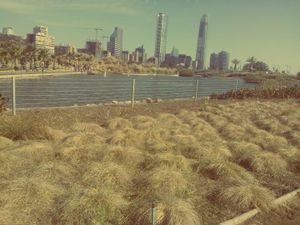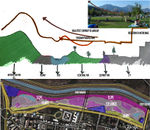Collaborative Design Planting Design Working Group 3: Difference between revisions
No edit summary |
|||
| Line 117: | Line 117: | ||
== What are the objectives of your design? == | == What are the objectives of your design? == | ||
We have a good foundation to work with and we would like build upon this by trying to: | |||
a.) '''Connect''' the park to its surrounding park areas, like the Metropolitan Park area etc. This will help provide a good view to the hill and create connection solutions between ecological zones and human activities. | |||
Including the shore of the river along its path | |||
b.) Trying to '''make the river as a part of our park''', or at least connect it to the park. This will serve an ecological purpose, by attracting more animal and bird species to the park and also explore its aesthetic potential. In this sense the river would be used like lagoons too, making it possible to use water as an ornamental element. | |||
c.) If, we are able to connect the river to the park well, we could even look at the '''river as a resource''', be it for irrigation or energy. Including the shore of the river along its path will help connect the park with the rest of the park system along the river, in this way the design will join the river, Bicentennial Park and the rest of the city in a '''park system'''. | |||
d.) '''Design green bridges''' to connect the Bicentennial park with the hill, in this way the visual connection achieve to become in real connection, allowing to visitors traverse the river and walking from one side of the city to the other. | |||
All of this would in turn encourage the '''interaction between the park and the urban fabric'''. This way '''urban green corridors''' could be introduced in Santiago and these could be used for social activities and of course, make it a more sustainable environment. | |||
And | |||
== Analytical drawings == | == Analytical drawings == | ||
Revision as of 14:44, 11 January 2014
---> back to group page working group 3
Bicentennial Park, Santiago, Chile
| Name | Bicentennial Park | |
| Location | Av. bicentenario 3800, vitacura, Santiago | |
| Country | Chile | |
| Authors |
Leslie Iturra, Mohammed Alkhanbashi, Nishtha Bali | |

| ||
Error in widget GoogleMaps: unable to write file /var/www/wikienfk5/extensions/Widgets/compiled_templates/wrt67eb7463bd5aa7_36145113
| ||
Landscape and/or urban context of your case
Project owner:Municipality of Vitacura.
Designer: Architect Teodoro Fernández (public contest).
Inauguration: 1st stage: December 2007 / 2nd Stage: November 2011
Total area: 314.314 m2 green area,
Path: 6 kilometers of pedestrian paths; 3,2 kilometers of bike ways
Vegetation: 4.000 trees which are native species 1.300.
Native Trees:(Chilean Names)
Bellotos: Protected specie, endangered, heights of 15 meters.(http://en.wikipedia.org/wiki/Beilschmiedia_berteroana)
Pataguas: heights of 10 meters, white flowers. (http://en.wikipedia.org/wiki/Crinodendron_patagua)
Peumos: heights of 25 meters, red edible fruit. (http://en.wikipedia.org/wiki/Cryptocarya_alba)
Quillay: heights of 20 meters, green/White flowers. (http://en.wikipedia.org/wiki/Quillaja_saponaria)
Arrayán: endangered, heights of 4 meters, cream color flowers, yellow fruit.(http://en.wikipedia.org/wiki/Myrceugenia)
Chilean Palm: partially protected, heights of 25 meters, edible nuts.(http://en.wikipedia.org/wiki/Jubaea_chilensis)
Espinos: heights of 5-6 meters, yellow flowers (http://en.wikipedia.org/wiki/Acacia_caven)
Non native species:
Holm oak (Encina): Mediterranean region, heights of 16-25 meters, (http://en.wikipedia.org/wiki/Quercus_ilex)
Oriental plane (plátano oriental): eastward from the Balkans, heights of 30 meters or more. (http://en.wikipedia.org/wiki/Platanus_orientalis)
Cockspur Coral Tree (Ceibo): Argentina , Uruguay, Southern Brazil and Paraguay, heights of 5- 8 meters, red flowers (http://en.wikipedia.org/wiki/Erythrina_crista-galli)
Jacaranda: central America, south America, cuba Hispanoila and The Bahamas, heights of 20-30 meters, purple-blue flowers.(http://en.wikipedia.org/wiki/Jacarand%C3%A1)
Lagerstroemia indica (crespón): China, Korea, Japan and Indian Subcontinent, heights of 6 meters, white, pink mauve, purple or carmine flowers. (http://en.wikipedia.org/wiki/Lagerstroemia_indica)
Sweetgum (liquidambar): heights of 25-40 meters (http://en.wikipedia.org/wiki/Liquidambar).
Cork Oak (alcornoque): Europe and northwest of Africa, heights of 20 meters (http://en.wikipedia.org/wiki/Quercus_suber)
Bald Cypress (ciprés calvo): USA, heights of 25- 40 meters (http://en.wikipedia.org/wiki/Taxodium_distichum)
Mexican fan palm (palma washintoniana): Western sonora and Baja california in Mexico. heights of 25 meters, white flowers (http://en.wikipedia.org/wiki/Washingtonia_robusta)
Parkinsonia: semi-desert of africa and America, heights of 5 -12 meters, yellow and white flowers, (http://en.wikipedia.org/wiki/Parkinsonia)
Lagoons: 2 artificial lagoons.
Wildlife: in the north lagoon lives different kind of birds such as Chilean Flamingo (http://en.wikipedia.org/wiki/Phoenicopterus_chilensis), Black-necked swan (http://en.wikipedia.org/wiki/Cygnus_melancoryphus), Koi Fish (http://en.wikipedia.org/wiki/Koi) and the followings has emigrated to the park: Great Egret (Garza blanca) (http://en.wikipedia.org/wiki/Ardea_alba), White winged Coot (Tagua) (http://en.wikipedia.org/wiki/Fulica_leucoptera)
Features of design:
The design aims to be a pole of physical and administrative activity, in the park are the public activities in general and the administrative one(including onto the design of the park) is in the municipality building. Moreover this park seeks to preserve some native species of Chile, including it as part of the design. the park has three different areas: (See image park areas)
a) Ramps of access, which joins the street and the park (because of the searching of privacy and visual continuity is under level of the street) under the uneven ground is the equipment program, so the land turn itself as an architecture program.
b) Central esplanade, which is the place where the most of activities occur. In this area is the pedestrian way to go along the park and the place to rest in the grass or play in the playground, as well as for children and pets. Also it is 2 lagoons the north one is reserved for the wild life by hosting different types of birds and fishes and the south one is reserved to play with boats (toys). The mass-activities has its place also in a little amphitheater and a esplanade beside the municipality building. The spiritual life is placed in a little oratory situated between the esplanade and the building.
c) The slope: which is a visual and acoustic screen that protect the park of the highway (and separates the park of the river) and create a lookout along the park.
- Maps
- Biogeography, cultural features, overall character, history and dynamics
- you can keep this short
- Illustration: Map; sketches; short descriptive analyses
What are the objectives of your design?
We have a good foundation to work with and we would like build upon this by trying to:
a.) Connect the park to its surrounding park areas, like the Metropolitan Park area etc. This will help provide a good view to the hill and create connection solutions between ecological zones and human activities.
b.) Trying to make the river as a part of our park, or at least connect it to the park. This will serve an ecological purpose, by attracting more animal and bird species to the park and also explore its aesthetic potential. In this sense the river would be used like lagoons too, making it possible to use water as an ornamental element.
c.) If, we are able to connect the river to the park well, we could even look at the river as a resource, be it for irrigation or energy. Including the shore of the river along its path will help connect the park with the rest of the park system along the river, in this way the design will join the river, Bicentennial Park and the rest of the city in a park system.
d.) Design green bridges to connect the Bicentennial park with the hill, in this way the visual connection achieve to become in real connection, allowing to visitors traverse the river and walking from one side of the city to the other.
All of this would in turn encourage the interaction between the park and the urban fabric. This way urban green corridors could be introduced in Santiago and these could be used for social activities and of course, make it a more sustainable environment.
And
Analytical drawings
Please add four analytical sketches/drawings (or montages/schemes) of your case. Every group member needs to contribute at least one drawing.
- Analytical Drawings
- Yourfilename1.jpg
analytical drawing 1
- Yourfilename2.jpg
analytical drawing 2
- Yourfilename3.jpg
analytical drawing 3
- Yourfilename4.jpg
analytical drawing 4
Projective drawings
Please add four projective sketches/drawings (or montages/schemes), of course with an emphasis on planting design/vegetation aspects. Every group member needs to contribute at least one drawing representing his/her individual ideas.
- Projective Drawings
- Yourfilename1.jpg
projective drawing 1
- Yourfilename2.jpg
projective drawing 2
- Yourfilename3.jpg
projective drawing 3
- Yourfilename4.jpg
projective drawing 4
Design Synthesis
Please analyse the individual approaches presented so far and evaluate their strengths and weaknesses (you may use the SWOTanalysis model). Try to create a synthesis and represent it with a plan and some sketches. You can still use drawings/sketches.
- Design Synthesis Drawings
- Yourfilename1.jpg
synthesis drawing 1
- Yourfilename2.jpg
synthesis drawing 2
- Yourfilename3.jpg
synthesis drawing 3
- Yourfilename4.jpg
synthesis drawing 4
Summary of the collaborative process
Please reflect on your collaborative design process. Which potentials have you encountered? What was most difficult? What does collaborative design mean for you? (approx 150 words).
Image Gallery
You may add a series of images/photos in addition to the sketches/drawings
- Image Gallery
- Yourfilename1.jpg
image 1
- Yourfilename2.jpg
image 2
- Yourfilename3.jpg
image 3
- Yourfilename4.jpg
image 4
References
* Please make sure that you give proper references of all external resources used.
* Do not use images of which you do not hold the copyright.
* Please add internet links to other resources if necessary.
About categories: You can add more categories with this tag: "", add your categories



